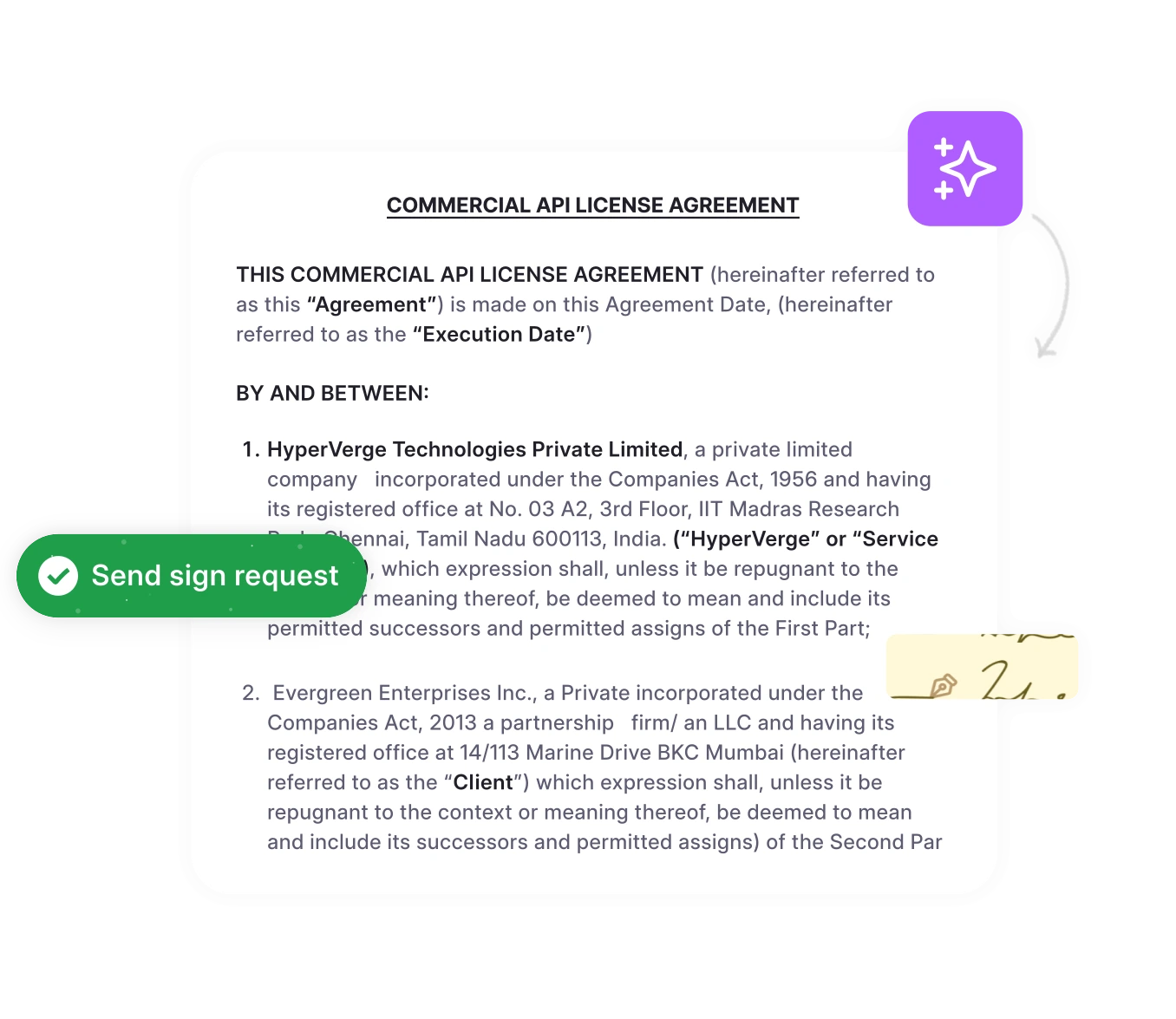Whether you’re managing vendor agreements, service contracts, or lease commitments, an unclear cancellation clause is tricky to navigate.
This comprehensive guide explains what a cancellation clause is, breaks down essential elements, provides real-world examples across seven contract types, and delivers practical drafting strategies. From understanding contract clauses to implementing effective cancellation provisions, you’ll learn how to protect your organization’s interests while maintaining contractual flexibility.
What is a cancellation clause?
A cancellation clause is a contract provision that specifies the conditions, procedures, and consequences for terminating an agreement before its natural expiration or completion. This cancellation provision establishes who can cancel, when they can cancel, how they must provide notice, and what financial or legal consequences follow.
Unlike contract termination, which typically ends an agreement prospectively due to breach or completion, cancellation often voids the contract as if it never existed or provides an exit mechanism during the contract term. Every cancelling clause should address four core components: cancellation conditions, notice requirements, financial consequences, and post-cancellation obligations that align with fundamental elements of a contract. What are the essential elements of a cancellation clause?
The cancellation clause usually includes four critical components that define how parties can exit an agreement while protecting their respective interests. These elements work together to create a comprehensive framework for contract cancellation.
| Element | What it defines | Common examples |
| Cancellation conditions | Who can cancel and under what circumstances | Material breach, inspection failure, force majeure, cancellation for convenience, mutual agreement |
| Notice requirements | Format, delivery method, and timeframe for notification | 30-day written notice, 60-day certified mail, 90-day advance warning, email with read receipt |
| Financial consequences | Penalties, refunds, and fee structures | Deposit forfeiture, pro-rated refunds, cancellation fees, payment for services rendered |
| Remedies and obligations | Rights of non-canceling party and surviving duties | Repayment terms, property return, confidentiality obligations, indemnification survival |
Understanding these elements helps legal teams draft comprehensive cancellation agreements that prevent disputes. According to the Federal Acquisition Regulation, all contract clauses governing termination and cancellation must be explicitly identified and incorporated to ensure enforceability and procedural compliance. Organizations maintaining a contract clause library can standardize these provisions across their contract portfolio while tailoring specific contract terms to individual business relationships.
Missing critical deadlines?
AI-powered CLM platforms automatically extract and track cancellation terms, notice periods, and renewal windows across your entire contract portfolio.
Book a DemoWhat are the different types of cancellation clauses?
Cancellation clauses vary significantly based on flexibility, triggering conditions, and party rights. The structure you choose depends on your industry, bargaining power, and risk tolerance.
| Type | Description | Notice Period | When Used | Example Language |
| Cancellation for convenience | Either party cancels anytime with notice | 30-90 days typical | Service agreements, consulting contracts | “Either party may cancel with 60-day written notice” |
| Conditional cancellation | Cancel only under specific conditions | Varies by condition | Real estate, purchase orders, project-based work | “Buyer may cancel if inspection reveals defects” |
| Mutual cancellation | Both parties must agree to cancel | By agreement | Partnership dissolution, joint ventures | “Contract ends upon mutual written consent” |
| Unilateral cancellation | Only one party can cancel | 30-90 days typical | Insurance policies, subscription services | “Provider may cancel with 30-day notice” |
| Early cancellation | Cancel before term ends with penalty | Per contract terms | Leases, fixed-term agreements | “Lessee may cancel with two months’ rent penalty” |
| No cancellation clause | Cancellation prohibited or restricted | N/A | Fixed-term commitments, bonds | “No cancellation permitted during initial year” |
| Non-cancellation clause | Guaranteed no cancellation by one party | N/A | Insurance (insurer guarantee) | “Coverage guaranteed for entire policy period” |
The 30-day cancellation clause remains the most common for ongoing service relationships, providing reasonable notice while maintaining flexibility.
More complex commercial arrangements often require 60-day or 90-day cancellation periods to allow for transition planning. A cancellation clause (30 days) typically appears in vendor agreements, while 90-day provisions are standard for enterprise software licensing.
Cancellation clause examples by contract type
Understanding how cancellation clauses function across different contract types helps legal teams draft industry-appropriate agreements that balance protection with practical business needs.
1. Service agreement cancellation clauses
Service contracts and freelance agreements require flexible cancellation provisions that address both ongoing relationships and project-based work. The service contract cancellation clause must account for work in progress, expenses incurred, and reasonable transition periods.
“Either party may terminate this agreement upon thirty (30) days written notice to the other party. If Client cancels after work has commenced, Client shall compensate Service Provider for all services rendered through the effective cancellation date, plus any non-refundable third-party expenses incurred on Client’s behalf. Service Provider must deliver all work product completed through cancellation date within five (5) business days.”
Key elements include:
- Equal cancellation rights for both parties
- Payment obligation for partial performance
- Work product delivery requirements
- Third-party expense allocation
Companies managing multiple service agreements benefit from standardized cancellation language while retaining flexibility to negotiate specific terms based on project scope and client relationship.
2. Lease and rental agreement cancellation clauses
Lease cancellation clauses must comply with landlord-tenant laws while addressing the unique challenges of property management. These provisions typically create asymmetric rights reflecting the different positions of landlords and tenants.
“Tenant may terminate this lease agreement upon sixty (60) days written notice and payment of an early termination fee equal to two (2) months’ rent. Security deposit remains subject to standard deductions for damages. Landlord may cancel for material breach with thirty (30) days written notice and opportunity to cure, or immediately for non-payment exceeding ten (10) days or illegal activity.”
Effective lease agreement cancellation clauses specify:
- Asymmetric notice periods(longer for tenant voluntary cancellation)
- Early termination financial penalties
- Landlord cancellation limited to breach scenarios
- Cure periods for correctable violations
- Security deposit handling
Organizations managing property portfolios should review lease renewal agreements alongside cancellation provisions to ensure consistency across their real estate contracts.
3. Insurance policy cancellation clauses
Insurance cancellation clauses are heavily regulated and vary significantly by policy type, jurisdiction, and whether cancellation is initiated by the insurer or policyholder. The insurance provisions of the cancellation clause must comply with state insurance regulations.
“Policyholder may cancel this policy at any time by providing written notice to the insurer. Upon cancellation, insurer shall refund unearned premium calculated on a pro-rata basis within thirty (30) days. Insurer may cancel with thirty (30) days advance written notice for non-payment of premium, or ninety (90) days notice for underwriting reasons or material misrepresentation.”
Insurance-specific considerations include:
- Asymmetric cancellation rights favoring policyholders
- Premium refund calculations (pro-rata vs. short-rate)
- Different notice periods based on cancellation reason
- State regulatory compliance requirements
- Non-cancellation clause variations where insurers guarantee coverage
The term “flat cancelled” refers to immediate policy cancellation, typically allowed only for fraud, misrepresentation, or non-payment during the initial policy period. A non-cancellation clause in insurance protects policyholders by guaranteeing the insurer will not cancel coverage except under narrowly defined circumstances.
4. Real estate and sales agreement cancellation clauses
Real estate transactions require detailed cancellation provisions that protect buyers during due diligence while ensuring sellers can enforce contract obligations. Real estate cancellation clause provisions typically include multiple contingencies.
“Buyer may cancel this listing agreement within seventy-two (72) hours of execution with no penalty. Following inspection period, Buyer may cancel if: (1) property inspection reveals material defects, (2) Buyer cannot obtain financing approval, or (3) title search reveals encumbrances. Seller may cancel if Buyer fails to close by deadline after all contingencies are satisfied. Upon proper Buyer cancellation, earnest money deposit shall be returned in full within five (5) business days.”
Effective sale agreement cancellation clauses address:
- Cooling-off period for initial reconsideration
- Inspection, financing, and title contingencies
- Earnest money deposit handling
- Seller’s limited cancellation rights
- Timeline deadlines and closing obligations
Real estate agents should understand that FHA cancellation clause requirements may impose additional buyer protections beyond standard contract terms.
5. Vendor and purchase order cancellation clauses
Business contracts require explicit vendor cancellation clause provisions that address supply chain management, inventory commitments, and work-in-progress. Cancelling a purchase order becomes particularly complex when blanket agreements span multiple delivery dates.
“Buyer may cancel this purchase order with fifteen (15) business days written notice if goods have not shipped. If cancellation occurs after production has commenced, Buyer shall compensate Vendor for: (1) raw materials purchased specifically for this order, (2) labor costs for work completed, and (3) reasonable overhead allocation. For blanket purchase orders, either party may cancel remaining unfulfilled orders with thirty (30) days’ notice.”
Critical elements for vendor contract management include:
- Pre-shipment vs. post-production cancellation rights
- Compensation for work in progress
- Blanket purchase order cancellation provisions
- Custom materials vs. standard inventory treatment
Organizations should align purchase order cancellation terms with their broader procurement contract strategy to ensure consistency across vendor relationships and supply chain management.
6. Event and venue contract cancellation clauses
Event contracts require sophisticated cancellation provisions due to substantial deposits, venue booking conflicts, and unpredictable circumstances, including weather, health emergencies, and force majeure events. The event cancellation clause must balance venue revenue protection with client flexibility.
“Client may cancel this wedding venue agreement with the following refund schedule: 180+ days notice receives full refund; 90-179 days receives 75% refund; 60-89 days receives 50% refund; 30-59 days receives 25% refund; less than 30 days results in complete deposit forfeiture. Venue may cancel only for: (1) force majeure events making performance impossible, (2) government restrictions prohibiting gatherings, or (3) property damage rendering venue unusable, with full refund required. For Covid-19 or similar pandemic restrictions: if government orders prohibit events of contracted size, Client may reschedule within 18 months with no penalty or receive 75% refund.”
Event-specific considerations reflect lessons learned from recent global disruptions:
- Sliding scale deposit refunds based on cancellation timing
- Force majeure clause provisions for extraordinary circumstances
- COVID-19 cancellation clause language addressing pandemic restrictions
- Inclement weather cancellation clause provisions for outdoor venues
- Act of god cancellation clause coverage for natural disasters
- Rescheduling options as an alternative to full cancellation
The International Chamber of Commerce notes that model force majeure and hardship clauses balance businesses’ legitimate expectations of performance with the reality that circumstances change, providing options to amend or terminate contracts when performance becomes untenable.
Read also, A Guide to Evergreen Contracts
Whether managing hotel contract cancellation clauses, speaker cancellation provisions, wedding photography cancellation terms, or artist and band contract cancellation language, the fundamental principle remains the same: clearly define triggering events, refund structures, and rescheduling alternatives.
Cancellation provisions are not just legal safeguards—they are operational tools that dictate how organizations recover from disruption, allocate risk, and preserve continuity.
Read
What is the difference between cancellation and termination clauses?
These terms are frequently used interchangeably in business conversations, but they carry distinct legal implications that affect past obligations, refund rights, and liability exposure.
| Aspect | Cancellation Clause | Termination Clause |
| Legal effect | Voids contract as if it never existed (rescission) | Ends contract prospectively from termination date |
| Past obligations | May be voided or reversed | Remain valid and enforceable |
| Future obligations | Cease immediately | Cease from termination date forward |
| Typical triggers | Cooling-off period, failed contingencies, mutual agreement, and consumer protection laws | Breach, expiration, completion, convenience, cause |
| Refund implications | Often includes full or partial refunds of amounts paid | Typically, no refunds for past performance |
| Common usage | Consumer contracts, real estate, and insurance policies | Service agreements, employment contracts, commercial relationships |
Understanding this distinction matters when drafting cancellation-of-contract provisions versus termination clauses. A cancellation contract typically allows parties to “unwind” the agreement, while a termination clause ends the relationship going forward without affecting completed performance.
For example, a homebuyer exercising a cancellation clause in a contract due to a failed inspection receives their earnest money deposit back because the contract is treated as void. However, an employer terminating an employment contract for cause must still pay wages earned through the termination date because past performance remains valid.
When drafting a cancellation agreement, specify whether you intend valid cancellation with retroactive effect or prospective termination. Using precise language prevents disputes about refund obligations and liability for past performance.
Standardize Contract Language
HyperStart’s templates standardizes contracts while maintaining flexibility.
Book a DemoWhat are common mistakes when drafting cancellation clauses?
Even experienced legal teams make drafting errors that create ambiguity, unenforceability, or unexpected liability exposure. These four mistakes appear most frequently in disputed contracts.
1. Vague cancellation conditions
The most common failure is using imprecise language that leaves parties uncertain about when cancellation rights exist. Generic phrases create more problems than they solve.
Bad example: “Either party may cancel this agreement for any reason upon reasonable notice.”
Good example: “Either party may cancel this agreement with sixty (60) days written notice delivered via certified mail or email with read receipt. Cancellation becomes effective on the 61st day following receipt of notice.”
The bad example leaves “reasonable notice” undefined and does not guide the delivery method or the effective date. Courts in different jurisdictions might interpret “reasonable” as anywhere from 10 to 90 days, creating unnecessary litigation risk.
2. Unclear notice requirements
Failing to specify precise notice mechanics leads to disputes about whether valid notice was provided. Ambiguity about format, delivery, and timing creates enforcement challenges.
Bad example: “Party seeking to cancel must provide notice to the other party.”
Good example: “Canceling party must deliver written notice by: (1) certified mail to the address listed in Section 15, (2) email to the designated contract administrator with read receipt, or (3) overnight courier with signature confirmation. Notice is deemed effective upon receipt, confirmed by delivery receipt or email read receipt.”
The bad example omits critical details about acceptable formats, delivery methods, and the effective date of notice. The good example eliminates ambiguity by specifying multiple acceptable delivery methods and defining the effective date.
3. Missing financial consequence details
Contracts that fail to specify refund obligations, cancellation fees, or payment for partial performance inevitably result in payment disputes. Financial ambiguity is especially problematic in service-based relationships.
Bad example: “Upon cancellation, parties shall settle accounts as appropriate.”
Good example: “Upon cancellation: (1) Client shall pay for all services performed through cancellation date at hourly rate specified in Section 4, (2) Vendor shall refund any advance payments for unperformed services within thirty (30) days, (3) Client shall reimburse documented out-of-pocket expenses incurred before cancellation notice, and (4) no cancellation fee applies if Vendor cancels, but Client shall pay 15% cancellation fee if Client cancels after work commences.”
The bad example provides no mechanism for calculating what each party owes. The good example creates a clear formula covering earned fees, advance payment refunds, expense reimbursement, and cancellation penalties.
4. Failing to address partial performance
Many contracts ignore the reality that cancellation often occurs mid-project after substantial work has been completed. Failing to address work in progress, materials purchased, or third-party commitments can lead to significant financial disputes.
Bad example: “Either party may cancel with 30 days’ notice. All obligations cease upon cancellation.”
Good example: “Either party may cancel with thirty (30) days’ notice. Upon cancellation: (1) Vendor shall deliver all completed work product within five (5) business days, (2) Client shall pay for work completed through cancellation date plus 25% of remaining contract value to cover committed resources, (3) Vendor shall transfer ownership of all custom materials created for Client, and (4) parties shall cooperate reasonably to minimize disruption and costs.”
The bad example creates ambiguity regarding work-product ownership, payment for partial completion, and transition responsibilities. The good example addresses these practical realities and establishes clear expectations for both parties.
An effectively drafted termination or cancellation clause should anticipate not only how a contract ends, but how performance, payment, and transition obligations continue.
Read
How to draft an effective cancellation clause
Strong cancellation clauses balance flexibility with protection by following systematic drafting principles that address legal requirements, business realities, and relationship dynamics. Organizations with robust contract drafting processes incorporate these five essential steps.
Step 1: Define clear triggering conditions
Begin by identifying all scenarios that permit cancellation, distinguishing between permissive and mandatory cancellation rights, and considering whether the parties need asymmetric flexibility.
- Breach-based cancellation: Material breach, repeated minor breaches, failure to meet performance milestones
- Convenience cancellation: No-cause cancellation with appropriate notice and possibly fees
- Contingency-based cancellation: Failed inspections, financing denials, regulatory disapprovals
- Force majeure cancellation: Natural disasters, government actions, pandemics, war
- Mutual agreement: Both parties consent to end the relationship
For complex commercial relationships, distinguish between immediate cancellation rights (fraud, insolvency, safety violations) and cancellation requiring notice periods (convenience, non-renewal).
Step 2: Specify exact notice requirements
Define minimum notice periods based on contract complexity, industry norms, and transition requirements. More extended notice periods (60-90 days) suit complex relationships with significant transition costs.
The cancellation clause wording should eliminate any ambiguity about how to write a cancellation clause that complies with your organization’s documentation standards.
- Format requirements: Written notice, specific contract language, required information
- Delivery methods: Certified mail, email with read receipt, overnight courier, hand delivery
- Confirmation requirements: Delivery receipt, signature, read receipt, proof of mailing
- Effective date calculation: Upon receipt, X days after mailing, specific calendar date
- Business days vs. calendar days: Specify clearly to avoid confusion
- Timezone considerations: For electronic notices across jurisdictions
The cancellation clause wording should eliminate any ambiguity about how to write a cancellation clause that complies with your organization’s documentation standards.
Step 3: Calculate proportional financial consequences
Determine appropriate cancellation fees or penalties that reflect actual costs, create fairness, and comply with penalty doctrine limitations. The cancellation fee clause should be commercially reasonable.
- Sliding scale deposit refunds based on cancellation timing
- Force majeure clause provisions for extraordinary circumstances
- COVID-19 cancellation clause language addressing pandemic restrictions
- Inclement weather cancellation clause provisions for outdoor venues
- Act of god cancellation clause coverage for natural disasters
- Rescheduling options as an alternative to full cancellation
Avoid punitive fees that courts might void as unenforceable penalties. Instead, structure consequences that reasonably reflect actual harm from cancellation.
Step 4: Address edge cases and exceptions
Anticipate unusual scenarios that create ambiguity or disputes, and build solutions into your cancellation provision language.
- Force majeure scenarios: Natural disasters, pandemics, government restrictions
- Mutual vs. unilateral procedures: Different processes for different cancellation types
- Surviving obligations: Confidentiality, IP ownership, indemnification, dispute resolution
- Dispute resolution: Mediation, arbitration, or litigation for cancellation disputes
- Consumer protection compliance: Three-day cooling-off periods, statutory cancellation rights
- Jurisdictional requirements: State-specific notice periods, format requirements
Brief consideration of consumer protection laws helps ensure compliance. For contracts involving door-to-door sales or specific regulated industries, mandatory 3-day contract cancellation clause provisions may override your negotiated terms.
Step 5: Review and test for clarity
Before finalizing cancellation language, test whether non-lawyers can understand the mechanics and whether the clause addresses all scenarios your business might encounter.
- Plain language test: Can the operations team understand without legal interpretation?
- Scenario testing: Walk through realistic cancellation situations
- Compliance verification: Confirm adherence to industry regulations and consumer protection laws
- Internal stakeholder review: Sales, operations, and finance perspectives on practical workability
- Legal review: Attorney verification of enforceability and risk allocation
Organizations maintaining template libraries should regularly update their cancellation clause sample provisions based on lessons learned from actual cancellation situations. Access to proven contract cancellation clause examples and contract cancellation clause samples accelerates drafting while ensuring consistency.
Streamline cancellation clause management with HyperStart
Effective cancellation clauses require precise language, awareness of compliance requirements, and proactive tracking across your contract portfolio. From service agreements to complex commercial contracts, clear cancellation provisions prevent disputes and protect business interests.
Managing hundreds of contracts with varying cancellation terms, notice periods, and deadlines quickly becomes overwhelming for legal teams using spreadsheets or shared drives.
HyperStart is a contract lifecycle management platform that helps legal teams manage cancellation provisions across their entire contract portfolio. Auto-extract cancellation terms, notice periods, and critical deadlines from executed agreements. Track upcoming cancellation windows with automated alerts that ensure you never miss a deadline.
Review and standardize cancellation clause language across contracts to ensure consistency. Draft compliant clauses using AI-powered templates and precedent libraries developed from your organization’s best practices. Never miss a critical cancellation deadline, auto-renewal window, or notice period again.











